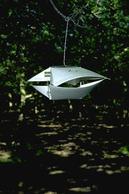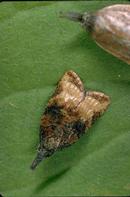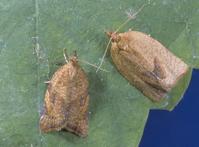|
Grape >
Year-Round IPM Program > Omnivorous Leafroller
and Orange Tortrix
Grape
Pheromone Traps, Omnivorous Leafroller, and Orange Tortrix
On this page
- Omnivorous leafroller
- Orange Tortrix
|
For omnivorous leafroller and orange tortrix
(shown below), look for male moths caught in pheromone traps to determine
biofix. Names link to more information on identification and management.

Wing-type pheromone trap.
|

Omnivorous leafroller
Identification tip: Male omnivorous leafroller moths
have blackish-gray, snoutlike mouth parts that protrude from the
head. Forewings are dark, rusty brown with a tan distal half. A dark
spot is located on the outer edge of the wings in the distal half.
|

Orange tortrix
Identification tip: Male orange tortrix (left)
moths are light brown or orange brown with a distinct V-shawped marking
on the center of each forewing and a pair of crescent-shaped markings
on the wing margins.
|
|


